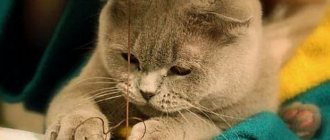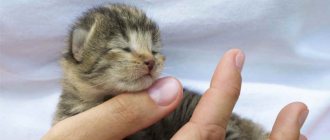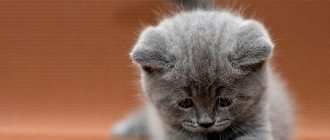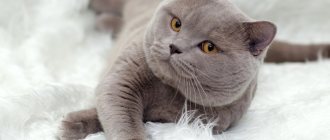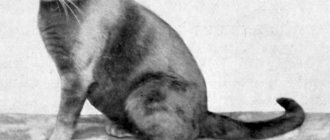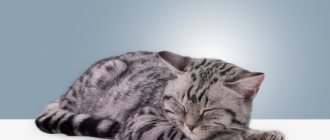Cats are quite capricious, freedom-loving, independent animals. Each individual, even within the same breed, has its own disposition, temperament, habits, and character. Some mustaches constantly require the attention of their owners and literally do not get off the laps or hands of their beloved owner, others are reluctant to make contact with a person and allow themselves to be stroked and cuddled only when they have the desire and the mood. How to raise an affectionate, easy-going pet? How to accustom a kitten to being held? You will learn the answers to these questions from this article.
Which breed and in what case is it better to choose?
It is better for a child to get a kitten than to introduce him to an adult cat.
For families with children, it is better to choose Scottish cats - kittens will get along well with children who already understand that a cat is a living creature and not a toy. "Scottish women" are completely devoid of sudden attacks of aggression. The British cat is suitable for busy people who respect the animal’s personal space. She will not behave aggressively with the child, but from an excess of attention to her person she will hasten to leave.
Video: the difference between Scottish and British cats
https://www.youtube.com/embed/Ra6sKc7Z9kw https://www.youtube.com/embed/ekiFbTEGalc
The Scottish cat breed is more suitable for families with children. In turn, the British one will fit perfectly into the life of a busy person who spends more time at work rather than at home.
What should you not do when trying to accustom an animal to your hands?
The owner of the animal should not:
- Before interacting with your pet, drink alcohol, eat citrus fruits and wear perfume. If a person emits odors that are frankly unpleasant for the animal, the cat will perceive the communication experience as negative.
- Make sudden movements. Suddenly grabbing your pet can frighten or even physically injure him.
- Hold the cat by force. Being willful and independent, representatives of the feline family prefer equal relationships built on mutual respect. If a pet does not want to sit in your arms at a particular moment in time, forcing it will only cause misunderstanding, resentment and anger.
- Drive the animal away from your lap when it decides to take the initiative in communication. Sometimes a cat's affection is inappropriate. However, even if the owner is in a hurry somewhere, pushing the pet away, he must remember that in this way he confuses the pet, nullifying all his previous efforts to establish contact with him.
Appearance of British and Scottish kittens
British and Scottish Fold kittens differences:
| Characteristics | British cats | Scottish cats |
| Body | They have a stocky and slightly squat body | More graceful features predominate. The body has relatively small dimensions |
| Head | Massive round head with a large jaw and pronounced cheekbones | The head is smaller, shaped like an owl's |
| Tail | Thick and muscular | Flexible and long |
| Ears | Straight, erect, rounded ears | Two types of ears: Scottish Strike (straight) and Scottish Fold (dropping) |
| Paws | Short, massive limbs | Slender paws with correctly selected proportions in relation to the body |
| Wool | Plush short fur | Fluffier with rich undercoat |
| Eyes | Oval oblong eye shape. Eye color is the most varied, orange shades dominate | Wide open round eyes. Color matches coat color |
Now you know that the Scottish fold cat and the British cat have differences in appearance and they are obvious. However, this is not all the individual characteristics of the two breeds.
The Scots and the British have different personalities, which is also important to consider when choosing a kitten to purchase.
How to distinguish fold-eared kittens from ordinary ones?
The chest is usually larger, and the legs and tail are shorter and thicker. Feel the kitten's nose - there should be no hump on the bridge of the nose. You also need to feel the tail - there should be no humps or knots on it. Buy a fold-eared cat in the cold season.
Interesting materials:
Do I need to update applications on my smartphone? Is it necessary to pick off the stems of bell peppers? Do I need to spray flowers in winter? Do I need to lighten my hair before dyeing it black? Do I need to unplug the surge protector from the outlet? Is it necessary to tear off the tails of rose hips? Is it necessary to renew the compulsory medical insurance policy? Do I need to show up at the employment center? Do I need to coat my nails with a base coat before applying extensions? Do I need to completely discharge a NiMH battery?
Why does the kitten not want to sit in your arms?
Unfortunately, not all small kittens are happy to sit quietly and spend time in the arms of their owner, especially in stressful situations or if the pet is very scared. In addition, not all furry cats require increased attention and avoid close contact with humans. This applies not only to wild street adult cats, cats of certain breeds, but also to kittens that you came out of a helpless little lump. But you really want to cuddle and caress your beloved pet.
Cats are arrogant
In most cases, cats allow themselves to be loved, accept our care, guardianship, and attention. Even a small kitten will not always sit quietly in your arms, allowing itself to be squeezed for hours
Remember that cats are very capricious and freedom-loving animals.
Why don't cats like to be held? The reasons for this behavior may be the following:
Breed characteristics, genetic predisposition.
Fear of heights, loss of balance. There are cats that are afraid of heights, weightlessness and do not like balance. Sitting in your arms, the kitten experiences fear and discomfort.
Incorrect socialization, adaptation.
Frequent stressful situations, mobile type of nervous system. If the cat is frightened or has suffered severe stress, even the calmest kitten, experiencing anxiety, will try to escape from the hands and run to a safe place.
Rough treatment of animals. Cats remember their abuser very well, and if you used physical violence, the pet will no longer fully trust you.
Strong unpleasant odors, according to the cat, emanating from the owner and his hands. Cats do not like the aroma of perfumes, especially citrus notes, or the smell of tobacco. Perhaps you have previously petted another cat or dog and the smell of the “stranger” scares the kitten away.
Street kittens and pets taken from shelters are reluctant to make contact. Since childhood, animals have not received much attention from humans and have been deprived of love and affection. It is possible that a street kitten was offended by a person, and the animal harbored a grudge against us for the rest of its life and no longer trusts the person.
Some breeds, due to their breed characteristics, also do not need increased attention and affection. For example, the British, Norwegian Forest, Scottish Fold, Siamese and their crosses.
Active, hyperactive, inquisitive kittens are reluctant to sit in your arms. It is difficult for them to sit in one place, much less on your lap or hands. After all, there are so many interesting things in the world.
Breeds whose representatives are distinguished by their dislike of hands and affection
Speaking about pets for whom a dislike for displays of affection is nothing more than a feature of the breed, one cannot help but recall the British Shorthair and Scottish Fold cats. In both of them, breeders have been trying for generations to develop independence and self-sufficiency. Having succeeded, felinologists received animals that were calm to the point of phlegmaticity and did not need anyone’s company.
The good news is that both British and Scottish cats do not feel discomfort when left alone for long periods of time, making them ideal pets for people who work a lot outside the home. However, the owner who returns after a long absence does not have to count on a warm welcome: representatives of the mentioned breeds refuse to “hugg” and sit on the arms out of principle, even if they really miss the person. Trying to forcefully accustom such an animal to handling is useless. It's against his nature.
Maine Coons, which are wild by nature, also demonstrate similar behavior. True, among representatives of this breed there are quite often pleasant exceptions to the rule, and if the cat owner is sure that his pet is one of those, it makes sense to try to teach the animal not to be afraid of hands.
Upbringing
If a pet has some bad habits, it will be difficult to wean it. It is better to try to prevent their appearance. As soon as the kitten appears in the house, he must understand what is allowed to do and what is not allowed.
Scottish cats are required to adhere to the following rules in the house:
- do not scratch furniture;
- rest and go to the toilet in the right places;
- do not harm the plants that are in the house;
- be friends with all pets;
- do not climb on tables or steal food;
- maintain cleanliness;
- do not show aggressive behavior.
Do not yell at the cat, otherwise it will become aggressive and will not trust its owner. The little kitten gets used to the new place and owner quickly. If the animal does something wrong, then you need to say the command “no” and lightly spank it. This breed loves to interact with people, and cats need to be played with regularly.
Cats follow a certain routine, so it is not recommended to disturb them in the morning and evening. If you wish, you can train a Scottish cat. They love to stand on their hind legs and stand on them for a long time. To raise a Scottish cat you will need to gain strength and patience.
Spray bait
Sometimes a cat must be accustomed to being handled using a special bait spray, which is sold in a pharmacy and usually contains catnip extract; this is necessary in cases where the kitten has been running wild for a long time and categorically refuses to make contact. Most often, this phenomenon is observed if the animal has suffered from people and because of this cannot help but fear even its owner, who loves it and has created comfortable living conditions for it. Also, basement kittens, which have largely returned to the behavior of their wild ancestors, are often distinguished by distrust.
The spray should be applied not to clothes, but to the palms of the hands, so that the kitten gets used to the person, and not to the thing. The smell of the product acts on the animal like a drug, and therefore the pet will, despite its fear, still run to the owner and rub against the hands. Gradually, the kitten will understand that there is nothing dangerous or unpleasant when communicating with a person. As a result of this, in the future, even without a spray, the pet will be willing to be handled.
When using a spray, it is important not to exceed the norm so that the baby does not become accustomed to it and begins to suffer from the lack of the drug. Because of this, you cannot use the product more often than once a day. This remedy should be used more often if you had to take an adult cat into your home.
Nutrition
In order for food to benefit the cat, you will need to follow some rules. First of all, there should be a balanced diet. As a rule, Scottish cats eat dry, wet food or eat natural food. The food should be of high quality and with a normal dosage of meat.
It is prohibited to mix natural food and feed at one time. It is allowed to give meat products, cereals and vegetables together.
The Scottish Fold cat needs to be given protein food. It is best to feed the animal low-fat meat products, fish, and dairy products.
When a kitten grows up, it must receive all the necessary fats; they are found in egg yolks and butter. The pet should eat on average 2-3 times a day in small portions. It is not recommended to feed a fold-eared cat in large quantities, as overeating can lead to obesity.
Colors of Scottish cats
Scottish cats come in a huge number of colors. They come in brindle, spotted, and marbled. The most popular shade of this breed is red. Scottish cats of this color have good intelligence and are easy to train. This pet has a bright and rich red hue. The color is located evenly throughout the body.
The Scottish cat's paw pads and nose are bright red. These cats have golden or copper colored eyes. In order to find an animal with this color, you need to make a lot of effort, since this shade is rare.
Breed Features
A good advantage of the Scottish cat is its good learning ability and love of cleanliness. Most cats of other breeds love to take revenge, but the Scotsman will never do this. From childhood, they quickly understand the toilet and learn to sharpen their claws in the right place.
The pet has a quiet voice, and he makes it only when he is hungry or calls for help. The cat has powerful paws and a body, he moves gently and gracefully.
You can go on a trip with this breed, as cats can easily tolerate travel. They quickly get used to new places and often participate in exhibitions.
The Scots have a calm and balanced character. This breed feels comfortable in an apartment, as they do not like to live in the yard. A fold-eared cat does not require a lot of space and care, but you need to give the pet the necessary attention. It is best to take the animal outside for socialization purposes.
In order for cats to be friends with other pets, they need to be taught friendship from childhood. They can easily get along with any dog, as they have an easy-going character.
Scottish Fold cats are friendly and affectionate in nature. It is important that the animal is raised from the very first days in the house. Then you will be able to raise a good and cute cat. The main thing is to love and caress your pet, and then the owner will receive reciprocity.
conclusions
Perhaps one day an arrogant British cat will jump onto your lap and delight you with her simple song. Despite their genetically inherent independence and self-sufficiency, British cats have the ability to be grateful and love their caring owner.
Every owner dreams of stroking and holding their pet on their lap. But why doesn’t the cat sit in your arms in response to affection, and even scratch, bite and growl with displeasure? Here are the main reasons for this behavior and ways to tame an animal and make it affectionate and gentle.
Reasons for behavior
Cats are freedom-loving and self-sufficient animals. Professional trainers know that it is almost impossible to force them to do something against their will, even force a cat to sit in your arms. Cats have different personalities from each other, just like people. Some are more affectionate, patient, friendly and capable of purring for a long time on their owner’s lap, others are strict and independent, not allowing themselves to be simply petted. British shorthair and fold-eared cats are especially susceptible to this. Often the cat chooses its own place in the apartment and, if it does not want to sit in your arms, nothing can be done, but sometimes it can be tamed.
Here are the main reasons why a cat won't sit in its owner's arms
:
- The kitten is constantly on the move. If something distracts his attention, he will not sit on his hands;
- Pungent odor from the owner. The cat's nose is very sensitive and does not like the smell of lemon, orange, alcohol, spices, washing powder, creams and perfumes;
- Memories of past grievances. If the previous owner beat the kitten, offended him, or if the cat grew up on the street and is not used to affection, he may not give in and not be handled. The cat will not sit in the arms of the person who offended him;
- Some animals are so independent that they don’t like being picked up by anyone, even their beloved owner. They begin to hiss and bite in response, expressing displeasure;
- The cat does not like to sit on laps because he is afraid of heights and loss of balance;
- The cat doesn't like to sit in other people's arms. He can perceive and love only the owner, but not the members of his family;
- A street cat does not like to sit on laps, as it is unfamiliar with tenderness and affection. Over time, he begins to shun any manifestations of tenderness;
- A purebred animal. British and fold cats do not like to be handled, remaining self-sufficient and independent;
- Fear. If an animal is scared, it will not be affectionate even with its owner. Cats cannot tolerate sharp sounds, screams, they can become frightened and in this state it is difficult even to simply pet them;
- The cat does not like to sit in the arms of children, as they squeeze it and offend it. Even if the child has grown up and doesn’t do this anymore, the cat remembers the insult and no longer asks to be held in his arms.
A characteristic feature of all cats is independence, resentment and vindictiveness. They will never sit in the arms of a person who offended them, hit them, or drove them away. The cat will not do anything against its will, much less sit in your arms. You need to make her want to do it.
How to properly hold a pet
First, it’s worth considering the basic rules for handling animals:
- Do not hold a cat against its will. If the animal doesn’t like it, it still won’t sit in your arms, so it’s better to let it go.
- Do not put too much pressure on your torso. If a cat is hurt, it will remember it and try to avoid such contact in the future.
- If your pet meows loudly, this is a signal that he is in pain or uncomfortable.
To pick up a pet, you should follow the following sequence:
- 1. Make sure the cat is free and friendly.
- 2. Approach him without sudden movements.
- 3. Call him affectionately, pet him or scratch him behind the ear.
- 4. If a cat purrs and looks into the eyes, this means that he is not against close communication with a person.
- 5. With one hand you need to grab the animal under the body by the front legs, with the other - by the hind legs and carefully lift it.
- 6. To make your pet feel comfortable, it is better to hold him close to you.
It is correct to hold a cat in your arms near your chest. You can’t restrict his movements, just lightly press him towards you. It is necessary to monitor the position of the pet's body; it should remain almost straight, without sagging or falling upside down. The cat's head should be slightly higher than its body. If the animal becomes uncomfortable, it will begin to break out of your hands, scratch or bite.

